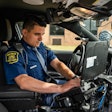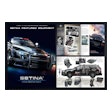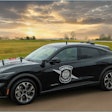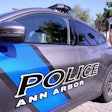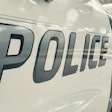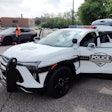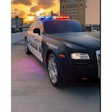On the third day I found myself heading into the gauntlet at about 10 miles per hour. The "gauntlet" is a double row of students at this three-day COBWEB (Cops On Bicycles With Education for Bicyclists) police mountain bike certification school. The students' instructions are to distract me as I ride by with light slaps on my body, raps to my helmet, etc. My fellow students are all mature, level-headed officers and they respect the bounds of these instructions. Here we go: slap, tap, rap, crash as I toppled off my Smith & Wesson bicycle. No one had hit me hard, no one had tried to cause my dump. In fact, about half the students who went through the gauntlet, as well as instructor Jeff LaFrenier, wound up crashing.
The valuable lesson learned: Don't go riding into a hostile crowd, as even slight perturbations of your bicycle can cause you to topple. Better to learn that lesson here in class on forgiving grass than during a real incident on concrete.
Another lesson learned: Even if you've been riding for years, it's a good idea to take a police mountain bicycle certification course. You will definitely learn something new.
Back to the Future
Police bicycle patrol is not a new idea. In the 1880s, police in many large cities patrolled their beats on bicycles. But when automobiles were introduced, response-based mobile patrol was substituted for beat-based proactive foot and bicycle patrol (which was the original community policing). With this change in approach, the benefits of bicycles were forgotten. Then in 1988, Sgt. Paul Grady, a bicycle enthusiast and police officer in Seattle, Wash., got permission to try out bicycle patrols in that city's downtown and waterfront districts. The ability of bicycle-based officers to circumvent the congested traffic and limiting roadways in these areas soon proved its merit. Officers could respond to a need for police action much faster than a cruiser could get to a scene, and they could get places that no cruiser could ever go.
That initial success led to a police bicycling popularity explosion, and today there are more than 2,000 active police bicycle units in the United States. Other emergency services, including EMS units are also using bicycles in congested areas. Imagine how quickly you could reach someone at an outdoor concert with a medical emergency. How long do you think it would take an ambulance to get through? A bicycle-riding EMT can be there in a fraction of the time.
The benefits of police bike patrols are numerous: It is much less expensive to field a bicycle officer than a cruiser-based officer. The average expense to fully equip one bike is about $1,200, with an annual maintenance fee of about $200. The average patrol car costs about $25,000 to purchase and has an annual maintenance fee of about $3,500.
Response time is quicker in urban and congested areas. Bicycles can go places that a cruiser can't get to, and that a foot officer won't reach in time.
Bicycle patrol is also silent and stealthy. The reports of police just riding up to crimes in progress are legion.
At the same time, the bike officer is visible and accessible to the community, and interacts with people more. This helps the department put a friendly face on its law enforcement efforts.
Officers directly benefit from being on bike patrol as well. Increased motivation is one benefit. It can be tough riding on a bike all day, but the exercise guarantees officers will be more physically fit.
Of course, nothing is free, and the disadvantages of bicycle patrol are that a limited geographic area can be covered, only a fraction of the equipment that a cruiser has can be carried, prisoners cannot be transported, and climate may dictate patrol suitability.
However, we should look at bicycle patrol as complementing traditional patrol, not replacing it. The success of the concept can be measured in the fact that bicycle patrols continue to increase - departments don't often voluntarily abandon them.
It is a rare city or even mid-sized town that doesn't have a bike patrol unit these days. Municipal police, sheriff's departments, state police, federal law enforcement, the Secret Service, EMS units, park police, military police, corporate security, campus police - all these units and more use bicycles as a crime-fighting tool today.
Proper Training
A bike program is not just a matter of choosing a few officers, issuing them bikes, and sending them on their way. The criteria for police bicycle officers should specify officers who are motivated, fit, proactive, good community interacters, and well developed in their law enforcement skills. This list does not describe every officer!
Getting properly trained is likewise critical. COBWEB is a Massachusetts-based organization devoted to training and educating police bicyclists. During the three-day certification course I recently attended, we covered the following areas (among others):
- Fitting the bicycle to the officer
- Fitness and nutrition
- The three bicycle mounts
- Various bicycle dismounts, including the power skid
- Rapid mounting and pursuit
- Riding in a straight line
- Riding very slowly
- Riding in small circles
- Riding through cone courses
- Jumping curbs
- Proper braking
- Riding in groups
- Riding down stairs
- Cover and contact with two bicycle officers
- Safe approaches to suspicious subjects
Although I've been riding a bicycle for more than 40 years and have been a recreational mountain bicyclist for nearly 15, I learned a lot in this course. Even if my department didn't require that I take this course, I would have to learn these skills somewhere, and COBWEB is a great place for it.
Let me mention one other lesson learned. On the last day, we all had to bicycle through a course that tested the skills we had learned, and we were competing for time. The last task was to dump the bike (a controlled set down) after a hard bike sprint then run to handcuff a "suspect." Every officer either nearly collapsed or fell as they started to run to the "suspect" - the change in muscle groups from biking to running, especially after the bicycle sprint, was the cause. Better not to learn this on the street![PAGEBREAK]
Proper Equipment
"A proper police patrol bicycle isn't just a recreational or competition bicycle with 'police' decals," says Dave Simard, Director of Public Safety Products at Smith & Wesson. "The average police bicyclist is heavier than the average competitive cyclist by tens of pounds, especially with all the equipment they wear and carry, and a bike cop may be on a bike 40 hours a week rather than just a couple hours at a time. All this adds up to a different bike than you can buy 'off the rack.'"
To meet the unique needs of law enforcement bicycle units, Smith & Wesson has its own frames built to custom specifications, and each bike is outfitted with a set of components optimized for police work. In addition, since S&W bicycles are built to order, a department can get components on their particular bicycles that may meet an unusual need that they have.
For 2001, S&W offers three product lines, each with many options in terms of components and accessories. The Patrol Bike is the entry level model built on an aluminum frame with SRAM 24 speed shifters and derailleur (a device for shifting gears on a bicycle by moving the chain between sprocket wheels of different sizes).
The Tactical Bike is the middle model with an aluminum frame, Shimano 27 speed Deore drivetrain, XT rear derailleur and Rock Shox Judy TT adjustable front suspension. The Custom bike is the top-of-the-line model, with an aluminum or Cromoly frame, Avid front Disk brake, Shimano XT, LX drivetrain, Rock Shox Judy XC front suspension and Shimano LX silent hub (for stealthy approach). Just introduced for 2002 is a full suspension version of the Custom Bike with air suspension from Rockshox Psylo front and a Fox RC rear with lockout.
All bikes come with (among many other things) a Topeak rack. Because these bicycles are designed specifically for cops, they have LE-friendly features, like the Topeak bag on the Custom Bike I borrowed for the course that had snap-on/off capability, unlike the usual cumbersome Velcro® attachment setup. There are also a host of LE-specific accessories available -l ights, bags, tools, etc.- even electric motor assists. Because S&W is the manufacturer, their bicycles cost considerably less than a comparably equipped bicycle bought elsewhere. If that is still too rich for your department, S&W has a leasing program available. Finally, any LE agency that buys a S&W bike gets access to a free multi-day maintenance training course!
Conclusion
Having now seen first-hand the benefits that cops atop bicycles can bring to law enforcement in their communities, I am struck by the question: Why did it take so long for this great idea to catch on?
Outfitting Yourself
Helmet You must wear a helmet when bicycling. On courses that I didn't consider difficult, I have fallen and smashed my (fortunately, helmet-protected) head hard onto rocks (big rocks). About 900 people a year die from bicycling accidents, 90% of those involving head injury. (See helmets.org, phma.org and safekids.org for more information.) Helmets should meet ANSI/SNELL/ASTM standards, and like body armor, be comfortable if they are to be actually worn. Bell/Giro, two well-known brands, have the largest test facility around and go so far as to perform cadaver tests on a test sled - a piece of equipment that no one else owns. Bell/Giro even shares test information freely with competitors, so committed are they to safety. I used both a Bell and Giro unit during this course and found them very comfortable.
Glasses Just like on the range, eye protection is a must. Glasses protect against UV, wind, and projectiles. In fact, a good pair of wrap-around shooting glasses make great bicycling glasses. I used the Wiley-X PT-1 for this course, and loved them. Their 8-base wrap-around design kept out wind and UV very effectively, and their fit was superb. Their multiple-colored interchangeable 2.3mm thick polycarbonate lenses exceed ANSI Z87.1 and military fragmentation standards.
Clothing Chamois-lined bicycle shorts and specific bicycle patrol shoes should be worn if an officer will be on a bike for an extended period of time. For intermittent or short-term bicycling, however, I found that the Blauer Street Gear shorts are just fine. I also found my Danner Radical 45 mid-height boots and my Original S.W.A.T. 6-inch duty boots to be comfortable for the same purpose.
The good news is that an officer can jump onto a bicycle for a particular call, or for a brief period of time, and be comfortable and function with their ordinary uniforms. Finally, while many units simply go with cotton jerseys as bicycle uniform shirts, Blauer makes a synthetic/cotton Street Gear shirt specifically for bike units with all the pockets and extras you expect on a true uniform shirt. The layered blend wicks moisture away from your skin, and the fluorescent yellow upper and sleeves provide daytime visibility while the reflective strips provide nighttime visibility.
Gloves Gloves are also necessary to prevent road rash during falls, nerve damage to the hands and carpal tunnel syndrome. For these reasons, choose gloves that provide protection during falls as well as support for your wrists.
For More Information
Manufacturers
1 Bellsports / Giro USA
2 Blauer Manufacturing
3 Danner, Inc.
4 Original SWAT Boots
5 Smith & Wesson Mountain Bike Division
6 Wiley-X
Training Organizations
7 International Police Mountain Bicycle Association
8 Law Enforcement Bicycle Association
9 COBWEB
Ralph Mroz is a police officer in Western Massachusetts. He is the author of a book and a video critiquing training methods, both of which are available from Paladin Press.









